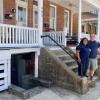On the wine front, much of the news has been about all the French producers and big Euroland money buying up the areas of our West Coast that abut the Pacific Ocean. Regulars know I admire W. Blake Gray’s usually insightful writings. Those with time should read his recent piece on Climate Edge Viticulture an excellent look at how recent warming trends are impacting the wine biz. My main take is: This invasion will likely drive the prices of cool-climate coastal Pinot Noirs to Red Burgundy levels over the next several years. If you cellar, are under 40 years old, believe we’re heading into a nasty recession and can sock Sonoma Coast PN away, start searching now. The goal is buy a case, keep until next uptick, sell half and have free great wine ready to drink. This is a great hedge. In fact, Rob McMillan, exec VP of Silicon Valley Bank’s wine division, says French are long term and may only be trying to diversify. “I don't think you can conclude that the French aren't worried about climate change. It is more likely that one of the influences behind the French purchasers is diversification of crop risk." Your downside: You will have twice as much great wine to drink. A caveat – look for wine that is from well-known producers, rated 94+ and has lower production; under 500 cases is a good target for best price appreciation. Sonoma Coast, Petaluma Gap and Fort Ross-Seaview AVAs (subregion) are a good place to start. Coastal Mendocino is also becoming more prominent.
A huge factor in the slower introduction of Pinot Noir to the cold coastal regions was that André Tchelistcheff, a recognized French star wine guy, was opposed. In 1938, Georges Latour brought him to Beaulieu in Napa as VP and chief winemaker. He instituted the long European knowledge of viticulture during the rebirth of California’s wine industry. Tchelistcheff is quoted as saying, “God made Cabernet Sauvignon, whereas the devil made Pinot Noir.” His repugnance was actually well founded. PN loves cool climates, but its thin skin and tightly packed, tiny berries are susceptible to rot and diseases that are inherent to high humidity. Familiars of coastal Cali will certainly remember the fog that rolls in during the evening and remains until late morning. The two Joes, Swan and Rochioli, famous in their own right, found clones that resisted these problems in the ‘60s. Most experts love PN because of its ability to reflect the terroir. Red Burgundy is noted for the variance in terroir-driven wine, where frequently a few rows of vines’ production will be quite different from the adjoining plantings. They also contend no other location has the terroir variances found in the 18 AVAs in Sonoma. Rochioli West Block 2015 just entered its window and will keep 12 more years, 97 McD as our findable reference. The following labels are worthy starting points: Williams Selyem, Davis Bynum, Hirsch Vineyards Reserve, which is my choice for best 2019, at price. I think many underrated this wine but JR and Virginia Boone were on the money. Around 95-96 and selling for $60, the price spiked to $165 on JR review then slid back to $80, a great buying point. They produce several labels in various price ranges; the 2018 and ‘19 were both great years in the region.



















































